Motorola Moto G Review
by Brian Klug on December 18, 2013 2:00 PM EST- Posted in
- Smartphones
- Motorola
- Mobile
- *VA
- Cortex A7
- snapdragon 400
- Moto G
Battery onboard mobile devices remains one of the biggest concerns for shoppers, and even in a mass market device like the Moto G it’s an important axis. Although Moto G has a removable back door, the battery isn’t designed to be user accessible and is sealed inside, there’s a sticker which pretty much explains the situation.
Inside, the Moto G has a 2070 mAh, 3.8V battery for a capacity of 7.9 watt hours. It loses the stacked 3D structure that was a highlight feature of the Moto X, but still is a relatively large battery for a device with a 4.5 inch LCD display.
To evaluate battery life we turn to our battery life testing suite, which we run over WiFi and all the cellular interfaces appropriate for the device. Here we see a good combination of regular spikes in CPU usage with idle time, hopefully simulating constant, reasonably paced usage. As always the display is set to exactly 200 nits and configured the same way we always configure devices for maximum consistency.
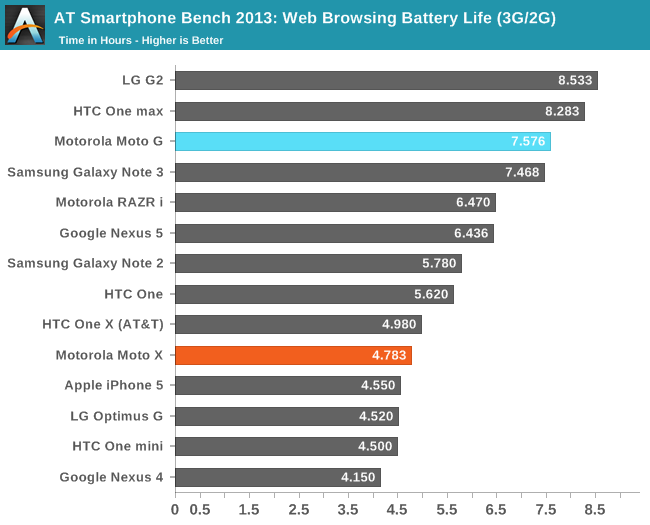
The Moto G starts out with an impressive result on 3G. There’s no LTE on the Moto G so we’re only looking at the subset of devices that I’ve tested on 3G with the new battery life test. Still it’s impressive that the Moto G can crank out just over 7.5 hours on here, considerably more than Moto X forced onto 3G.

The WiFi test opens up considerable more comparison points, and here I’m really impressed by what the Moto G is able to crank out.
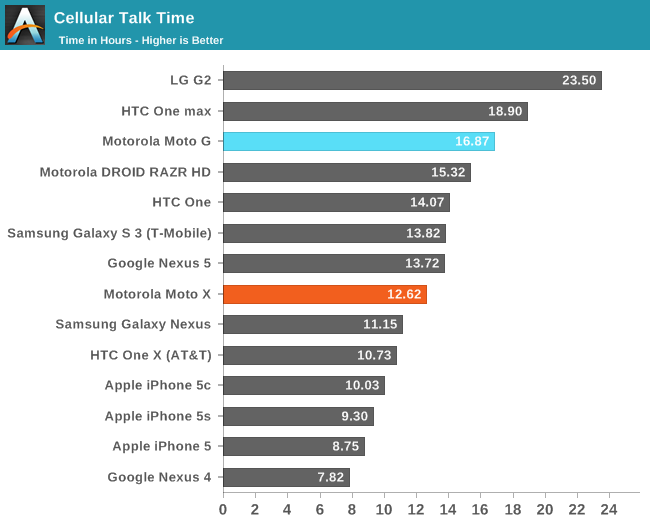
Cellular talk time is self explanatory, and again the Moto G winds up with an impressive result. I remember when Motorola seemed to somehow always be able to dominate the call test, Moto G definitely reminds me of those days.
Compared to the Moto X, the WiFi and 3G battery life tests really wind up being a story of the power consumption tradeoffs between LCD and AMOLED that remain to this day. The display size to battery capacity ratio is pretty big with the Moto G, and of course there are further improvements to overall efficiency with the latest Qualcomm silicon and modem block inside.
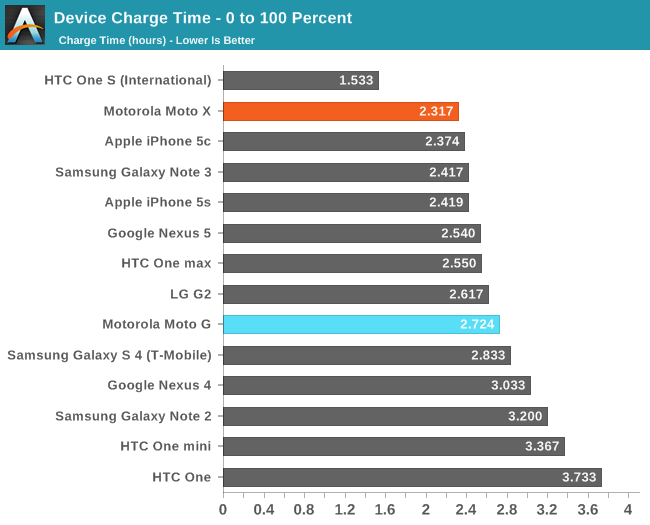
I mentioned that the Moto G doesn’t come with a charger in the box, a choice which cuts down on cost and is starting to make a lot of sense give the ubiquity of cheap USB chargers.
Thankfully Moto G seems to be good about its charge signaling, as it can pull up to 2 amps on appropriate chargers. The Moto G seems to be compliant with BC 1.2, and seems well behaved with drawing whatever is appropriate from other chargers as well.


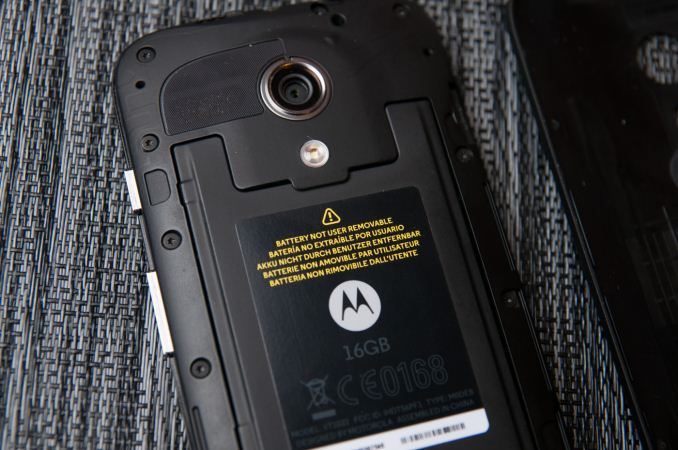
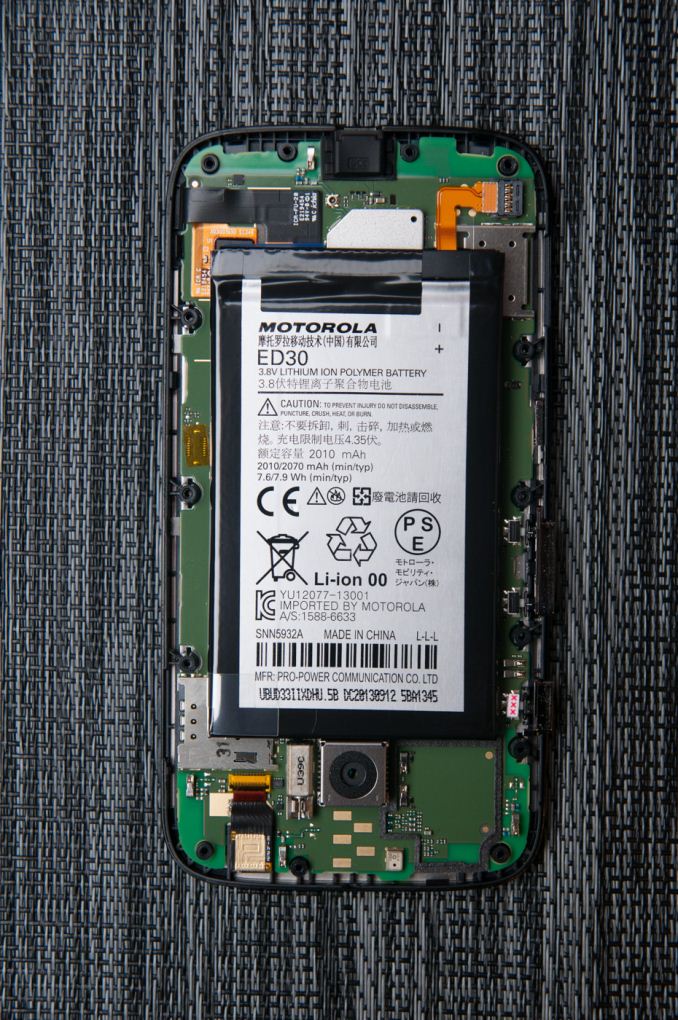
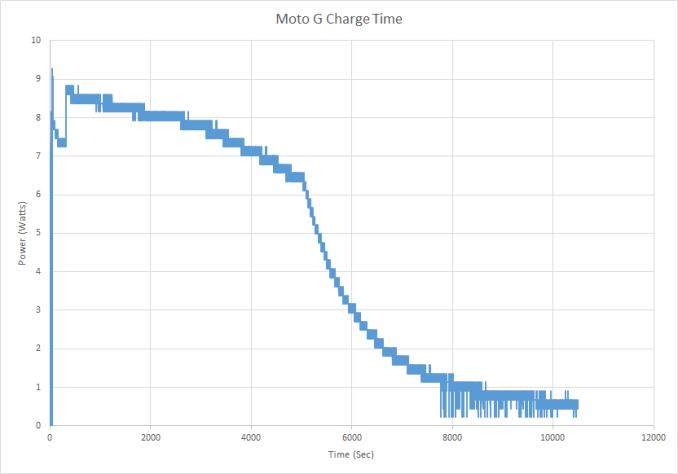








120 Comments
View All Comments
bhima - Monday, December 23, 2013 - link
The market are people that, for example, pay only $25 a month each on a T-mo family plan and they don't want to drop an extra $30 a month for 2 years for a phone, Or sign up for a contract with ATT/Verizon and blow easily $60+ a month. 500mb of data at HSPA+ speed (9mbps in my area) with no overage charge, unlimited talk and text for $25 a month makes this phone a huge winner to those willing to look for a good experience without burning a hole in your wallet.teiglin - Wednesday, December 18, 2013 - link
Every time I read reviews of this I'm surprised at how closely MSM8x26 performs to flagships from as recently as last year. Obviously it isn't really in the running compared to 8974, Apple A7, Exynos 5250, etc., much less APQ8064, so I think this says more embarassing things about companies that shipped quad-A9 flagships in mid-to-late-2012, but still, the end result is that the display and silicon leads to an experience comparable to (if not better than) a GS3 i9300. This is pretty surreal at the sub-$200 price point, while a new i9300 still goes for ~$400. Of course there are other sacrifices and if we're talking about $400 life begins and ends with the Nexus 5, but still, Motorola has really accomplished something with the Moto G. This is the phone I'd buy for my son if he were five years older; hopefully by the time he's old enough to have his own smartphone, Motorola will be still have something comparable on sale so he can get a quality device at this price point.teiglin - Wednesday, December 18, 2013 - link
Exynos 5420. Not really sure where 5250 came from, but... thingssayash - Thursday, December 19, 2013 - link
5250 is now more than a year old, it was the soc in the nexus 10, so yeah.Bobs_Your_Uncle - Thursday, December 19, 2013 - link
By the way, how's that Nokia 1020 review coming?Klug4Pres - Thursday, December 19, 2013 - link
Brian, I am curious about the impact of operating system version on the benchmark comparisons. Presumably the results in your tables are based on whatever version was installed at the time of initial testing, which is perfectly reasonable.However, it would be interesting to gauge the impact of, for example, new Android versions on a device's scores. Is there an appreciable change in performance going from, say, 4.2 to 4.3 or 4.4 on Nexus 4?
I realise it would be a lot of work to try to update all benchmarks on every software release across every OEM, and anyway you do not necessarily retain access to most of the devices you test, but this might be feasible on just the Nexus devices, which I have a feeling you tend to keep around. On the other hand, maybe the results aren't really very interesting.
Qwertilot - Thursday, December 19, 2013 - link
Fascinating to see what happens with and its relatives/competition in next few years.In a sane world this sort of thing would take huge chunks of the market for high end phones. The current market with the very expensive ultra high end models selling so much at such premiums surely can't be sustainable long term.
Only thing is that I'm not sure how rational this market is :)
uhuznaa - Thursday, December 19, 2013 - link
With smartphones and tablets becoming a mass-market it will be as rational as any other market. Like clothing, shoes or food. Which means not very rational, there will be room for huge price spans and very different products, some of them rational and others not at all. This is hard to digest for geeks, I know.Qwertilot - Thursday, December 19, 2013 - link
True. The special thing for the mobile market is the rather big locked in distortions via contracts/subsidies etc.Certainly nice to have this sort of option around.
ESC2000 - Monday, December 23, 2013 - link
problem is that the average person thinks s/he needs the newest shiniest most powerful device that she will probably never take advantage of, and the up front subsidy (but pay out the rear) system facilitates the impulse to purchase an overly powerful device in the US by making Americans less price sensitive. It is really annoying to listen to people who think a small very powerful computer that pushes more pixels than their laptop only costs - and should only cost - $200 at most.